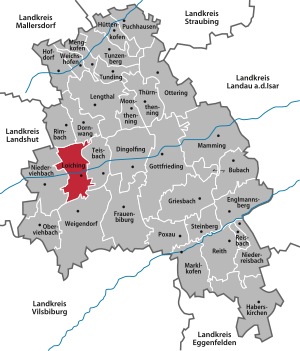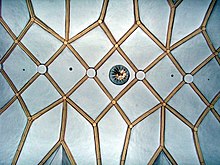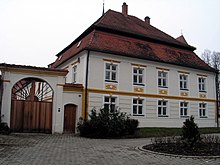Loiching
| coat of arms | Germany map | |
|---|---|---|

|
Coordinates: 48 ° 37 ' N , 12 ° 26' E |
|
| Basic data | ||
| State : | Bavaria | |
| Administrative region : | Lower Bavaria | |
| County : | Dingolfing-Landau | |
| Height : | 385 m above sea level NHN | |
| Area : | 38.92 km 2 | |
| Residents: | 3606 (Dec. 31, 2019) | |
| Population density : | 93 inhabitants per km 2 | |
| Postal code : | 84180 | |
| Primaries : | 08731, 08744, 08732, 08702 | |
| License plate : | DGF, LAN | |
| Community key : | 09 2 79 124 | |
| LOCODE : | DE ZAV | |
| Address of the municipal administration: |
Kirchplatz 4 84180 Loiching |
|
| Website : | ||
| Mayor : | Günter Schuster ( CSU / non-party citizens) | |
| Location of the municipality of Loiching in the district of Dingolfing-Landau | ||

Loiching is a municipality in the Lower Bavarian district of Dingolfing-Landau .
geography
location
Loiching is in the Landshut region . The municipality extends from the Isar valley in the north with Kronwieden to the south and, spreading over two valleys, extends over a predominantly agricultural and forestry hill country over the place Wendelskirchen almost to the northern ridge of the Vilstal valley.
Parish parts
The community comprises the following 45 community parts: In addition to the main town or parish village of Loiching, this includes the church villages Oberspechtrain , Piegendorf , Weigendorf and Wendelskirchen as well as the villages of Buchet , Kronwieden , Oberwolkersdorf and Unterspechtrain , but also the hamlets of Anzenbrunn , Baiersdorf , Bergham , Ehrenreith , Eässig , Feldkirchen , Goben , Göttersdorf , Grafenwald , Haindlfing , Krottenthal , Lehen , Loichingermoos , Maßendorf , Oberteisbach , Oed , Pischelsdorf , Reinöd , Reit , Unterwolkersdorf and Wornstorf as well as the deserted areas ( individual settlements ) Atzbach , Baumgarten , Deixlerisingb , Erb , Gummeringerau , Heck , Heelberg , Nußberg , Pfeffersberg , Polling , Rampelsberg , Staudach , Stemmern , Sterzenreith and Wastlmühle .
Markings
There are the districts Loiching and Weigendorf .
The districts of Loiching, Bergham, Eässig, Feldkirchen, Gummeringerau, Kronwieden, Loichingerau, Loichingermoos, Oed, Wastlmühle are in the district (original community) Loiching, the rest in the district (former community) Weigendorf.
Waters
The Scheiblbach flows through a large part of the municipal area from its source near the hamlet of Pischelsdorf in the south to the north to its confluence with the Isar immediately east of the Isar bridge. The creek has a length of 6.7 km. Up to the mouth of the Baiersdorfer Bach a little above Weigendorf it is also called Pischelsdorfer Bach .
The ponds in Loichingermoos extend northwest of the Kronwieden district .
history
Loiching was first mentioned in a document on August 25, 885. Emperor Karl III. , called "the fat one", gave the chapel in Ötting the ninth part of the income from 21 localities belonging to the royal estate, including "Liuchingan", Loiching. The scattering of these royal goods suggests that their size should not have been insignificant. Presumably they emerged from the agilolfingian ducal estate.
For a long time, today's municipal area belonged to the domain of the Counts of Frontenhausen and after their extinction in 1226 it fell as an inheritance to the bishops and the cathedral chapter of Regensburg. Secular rule came to the Duchy of Bavaria in 1386. Loiching, Weigendorf and Höfen (excluding the part of Höfen belonging to the Teisbach market) were chairmen of the Teisbach office in the Teisbach district court in the ducal and electoral Bavaria . In the course of the administrative reforms in the Kingdom of Bavaria , the municipal edict of 1818 created the municipalities of Loiching (from the chairmen of Loiching and Höfen) and Weigendorf. However, parts of the former community of Weigendorf belonged to other domains. On January 1, 1946, by order of the American military government, the area of the former chairman of Höfen had to be assigned to the market town of Teisbach (districts of Höfen (including Neuhausen), Schönbühl and Gaubitzhausen) and to the city of Dingolfing (district of Grüblhof including Rostmühle).
The previously independent municipalities of Loiching and Weigendorf merged voluntarily on April 1, 1971 as part of the municipal reform with their headquarters in Weigendorf. In 1978 and 1979, the Loiching community was part of the Niederviehbach administrative community based in Niederviehbach . This was dissolved on January 1st, 1980 at the instigation of the Loiching community. The seat of the municipality Loiching has since been in the village of Loiching.
Population development
In the period from 1988 to 2018, the municipality grew from 2,896 to 3,590 by 694 inhabitants or 24%.
- 1961: 2166 inhabitants
- 1970: 2296 inhabitants
- 1987: 2871 inhabitants
- 1991: 3109 inhabitants
- 1995: 3316 inhabitants
- 2000: 3528 inhabitants
- 2005: 3595 inhabitants
- 2010: 3546 inhabitants
- 2015: 3508 inhabitants
politics
mayor
Günter Schuster (CSU) has been mayor since May 1, 2008; he was elected for a further six years on March 15, 2020 with 93.2% of the vote, with no opposing candidate.
Municipal council
Local election 2020 seats:
The turnout was 64.8%. Compared to the 2014–2020 term of office, the number of seats in the CSU and FWG remained unchanged; the SPD had to hand over a seat to the new candidate Greens.
coat of arms
Blazon : Through a thorn-shaped silver sloping bar at the top and lobed at the bottom, divided by green and red; a slanted silver fish above, a slanted silver key below.
Explanation: The colors red and silver as well as the notch cut of the bar are taken from the coat of arms of the Counts of Frontenhausen. The colors red and silver and the bar also come from the coat of arms of the bishopric (the bishops of Regensburg). The fish and key are taken from the seal of the Regensburg cathedral chapter and are also intended to remind of the Loichingen parish church, which is consecrated to St. Peter and St. Paul. The fish and the wave-like shape of the bar are references to the location of the municipality on both sides of the Isar.
Town twinning
-
 Poland : The partner municipality is the municipality of Sławoborze (German Stolzenberg ) in the Świdwiński district .
Poland : The partner municipality is the municipality of Sławoborze (German Stolzenberg ) in the Świdwiński district .
Culture and sights
Catholic parish church of St. Peter and Paul
The parish church of St. Peter and Paul in Loiching is a stately single-nave building, the basic structure of which dates from the late Romanesque period. The choir as well as the nave vault and the tower date to the middle of the 15th century. The interior of the church is largely baroque. The high altar from 1628 is impressive and takes up the entire height of the choir and is flanked by two larger than life statues of the two church patrons. The importance of the stately rectory as the former summer residence of the Regensburg cathedral chapter is still recognizable today.
Chapel Heimlichleiden
The Heimlichleiden chapel belonging to the Oberteisbach district is located near the border with the town of Dingolfing .
Architectural monuments
Economy and Infrastructure
Economy including agriculture and forestry
In 1998, according to official statistics, there were 16 employees in the field of agriculture and forestry, 183 in manufacturing and 151 in the field of trade and transport. In other economic sectors 104 people were employed at the place of work subject to social security contributions. There were 1290 employees subject to social security contributions at the place of residence. There were none in the manufacturing sector and four in the construction sector. In addition, in 1999 there were 115 farms with an agriculturally used area of 2,344 hectares, of which 2,090 hectares were arable land and 247 hectares were permanent green areas.
education
In 1999 the following institutions existed:
- Kindergartens: 75 kindergarten places with 119 children
- Elementary schools: one with 18 teachers and 313 students
Honorary citizen
- Former Mayor Johann Huber
- Pastor Lorenz Speckner
- Former Mayor Max Haslbeck
- Episcopal Spiritual Council Pastor Sebastian Schall
- Pastor Albert Menhart
- Former Mayor Reiner Schachtner
- Pastor Josef Forstner
literature
- Martin Hobmeier: Chronicle of the community Loiching. Secular and ecclesiastical from the old parishes of Loiching and Weigendorf . Volume II, Wälischmiller'sche Buch- und Offsetdruckerei, Dingolfing 1989, DNB 900293233
- Hermann Raith: The conflict between the parishes of Teisbach and Loiching over the so-called "Teisbach Enclave": a legal historical contribution to the problem of community formation in Bavaria in the 19th and 20th centuries . Dissertation , Regensburg 2007. Eichendorf Verlag, 2007, ISBN 978-3-930648-70-2
Web links
- Entry on the coat of arms of Loiching in the database of the House of Bavarian History
- Loiching: Official statistics of the LfStat (PDF; 1.66 MB)
- Location database of the BLO
Individual evidence
- ↑ "Data 2" sheet, Statistical Report A1200C 202041 Population of the municipalities, districts and administrative districts 1st quarter 2020 (population based on the 2011 census) ( help ).
- ^ Community Loiching in the local database of the Bavarian State Library Online . Bayerische Staatsbibliothek, accessed on September 24, 2018.
- ^ Wilhelm Volkert (ed.): Handbook of Bavarian offices, communities and courts 1799–1980 . CH Beck, Munich 1983, ISBN 3-406-09669-7 , p. 447 .
- ↑ Werner Kohl: The development of our community 1971–1985 . in: Community Loiching (ed.): Festschrift for the 1100th anniversary of the community Loiching (885–1985) . Loiching 1985, pp. 59-95
- ↑ http://www.loiching.de/rathaus/gemeinderat/






